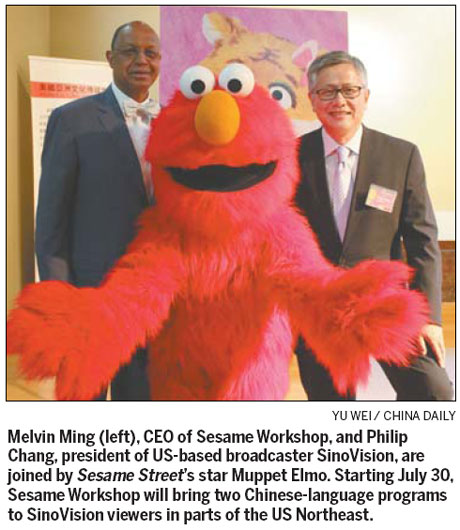Sesame Street opens door to Chinese children
Updated: 2012-07-27 12:07
By Zhang Yuwei and Yu Wei in New York (China Daily)
|
||||||||

Video: Elmo teaches Chinese in US
When the head of the company that produces the award-winning children's program Sesame Street visited its production set in China last month, everything looked the same as it does in the US original -the colorful, furry Muppets, the catchy music and the fun but educational story lines.
But one difference stood out on this Sesame Street in Shanghai: All of the Muppets were speaking Mandarin.
"We were proud of it because the content was authentically Sesame, and authentically Chinese," said Melvin Ming, CEO of Sesame Workshop."It was a win."
Sesame Street was relaunched in China in December 2010 - 13 years after its debut in China. Sesame Workshop has a team of Chinese producers and writers in Shanghai - all trained by the New York-based nonprofit - who are responsible for putting Big Bird Looks at the World and Fun Fun Elmo, a new series, on the air.
In China, the shows are broadcast on HaHa channel by Shanghai Media Group's Shanghai Toonmax Media Co, and on China Central Television children's channel, reaching about 200 million school-age kids.
"We think having a Chinese-language Sesame Street will be a desired commodity in every Chinese community around the globe - be it in America, Shanghai or Trinidad," Ming said.
The production company, which was founded in 1969 as the Children's Television Workshop, has a bigger plan and aims to reach Chinese audiences, inside the country and in Chinese communities abroad.
Last week in New York, Sesame Workshop unveiled its two China-produced programs on SinoVision, the main Chinese-language TV broadcaster in the US, serving Chinese-speaking viewers in New York, New Jersey, Connecticut and Pennsylvania.
The shows on SinoVision will present the mystery and magic of the language to communities where children are learning Chinese from very young ages, Ming said.
"It will put the pictures with the language, and it will make the learning deeper. It will create cultural bridges between the US and China," he added.
Philip Chang, president of SinoVision, called the channel's first-time collaboration with Sesame Workshop a "milestone".
"The cooperation signifies that the Chinese market is receiving more and more attention from American mainstream media. It also marks a milestone in our program diversification," Chang said.
The Fun Fun Elmo series, with animation and live action shot in China, will expose youngsters to Mandarin, with each episode introducing a tone, word and writing-stroke method for a character in the Chinese alphabet.
Local educators see the TV tie-up as a good option for children learning Chinese.
"Sesame Street on SinoVision may make speaking Chinese more meaningful and relevant for Chinese-American kids, and may spark an increased interest in speaking Chinese. When they see Elmo and Big Bird speaking Chinese, they will want to as well," said Robin Harvey, who teaches multilingual and multicultural studies in New York University's Teaching and Learning Department.
"The program will serve to build and reinforce Chinese language skills in the Chinese-American community, and to introduce Chinese to Americans who want to learn Chinese," she said.
The milestone, said Ming, is only the beginning of Sesame Workshop's outreach to Chinese audiences. He hopes the new programs will reach an even larger audience beyond the US that is interested in Chinese learning.
Ming travels to China regularly to observe the domestically produced Sesame Street shows and to understand the country's growing market.
Sesame Street has versions in 30 languages that are broadcast in over 150 countries. With a goal of reaching all of the world's 1.2 billion young children, China is high on the Workshop's wish list, Ming said.
The fast-growing market continues to offer new elements to producers, local and foreign alike.
Ming said that when he met with young Chinese animators during a recent trip, he was impressed by how well they used their art to educate as well as entertain.
In this, he saw a match.
"It was a great opportunity for me, a Westerner, to see young animators who are thirsting, looking for opportunities to use their art to create authentic Chinese media and get it distributed.
"Sesame can offer opportunities for young professionals to find ways to use traditional art - in this case animation - to make kids smarter, brighter, and more connected.
"To me, China is a land of opportunity."
Contact the writers at yuweizhang@chinadailyusa.com and yuwei12@chinadailyusa.com

 Relief reaches isolated village
Relief reaches isolated village
 Rainfall poses new threats to quake-hit region
Rainfall poses new threats to quake-hit region
 Funerals begin for Boston bombing victims
Funerals begin for Boston bombing victims
 Quake takeaway from China's Air Force
Quake takeaway from China's Air Force
 Obama celebrates young inventors at science fair
Obama celebrates young inventors at science fair
 Earth Day marked around the world
Earth Day marked around the world
 Volunteer team helping students find sense of normalcy
Volunteer team helping students find sense of normalcy
 Ethnic groups quick to join rescue efforts
Ethnic groups quick to join rescue efforts
Most Viewed
Editor's Picks

|

|

|

|

|

|
Today's Top News
Health new priority for quake zone
Xi meets US top military officer
Japan's boats driven out of Diaoyu
China mulls online shopping legislation
Bird flu death toll rises to 22
Putin appoints new ambassador to China
Japanese ships blocked from Diaoyu Islands
Inspired by Guan, more Chinese pick up golf
US Weekly

|

|






